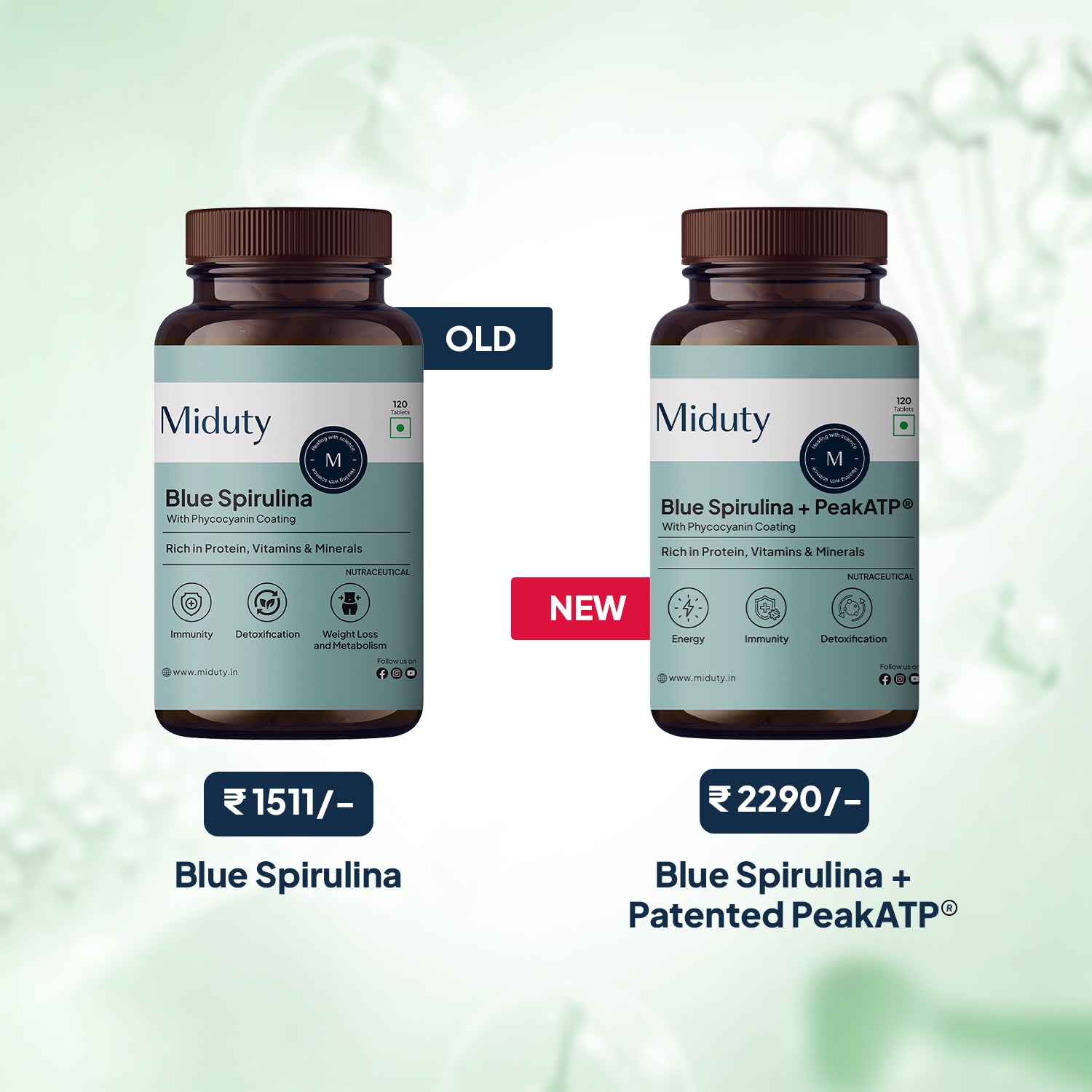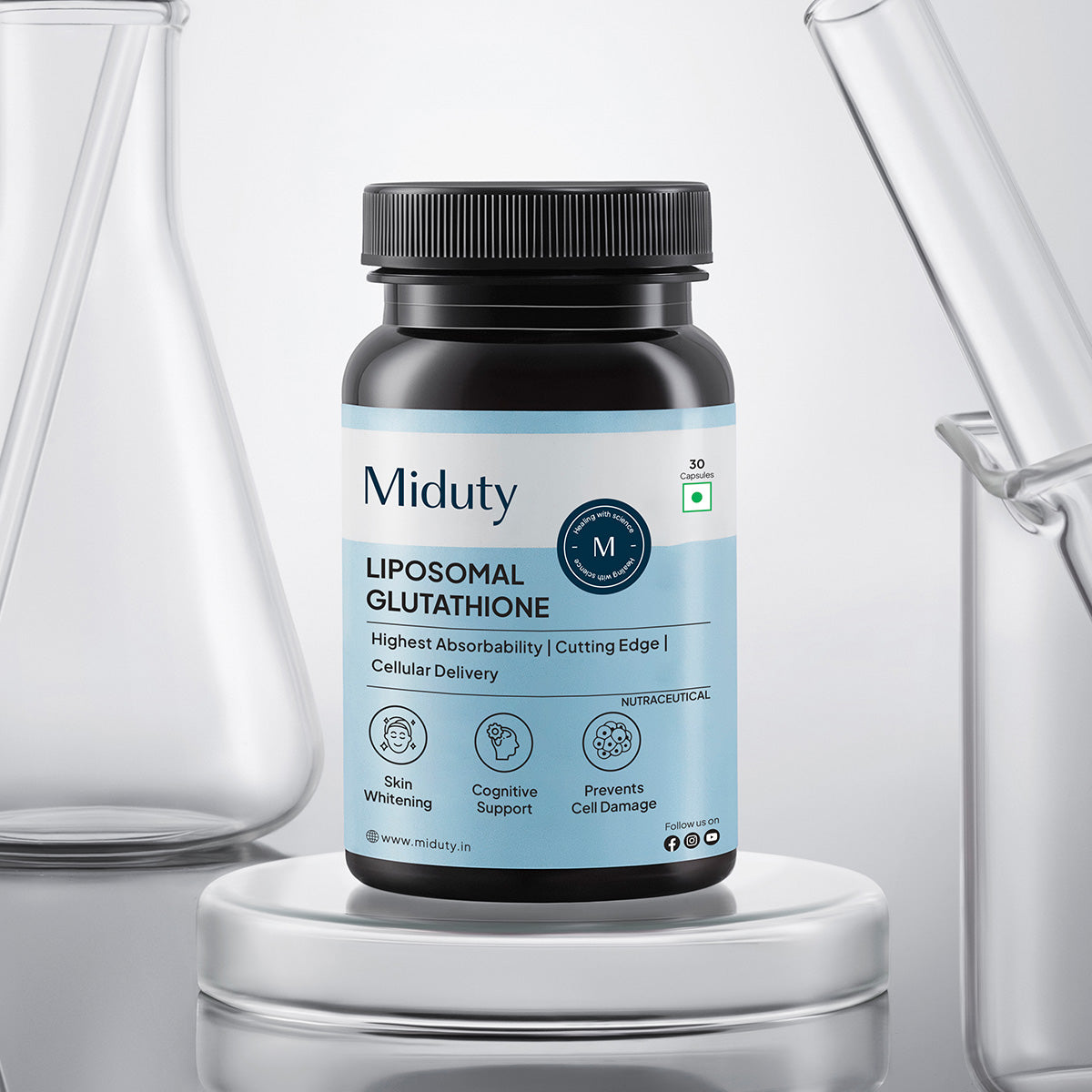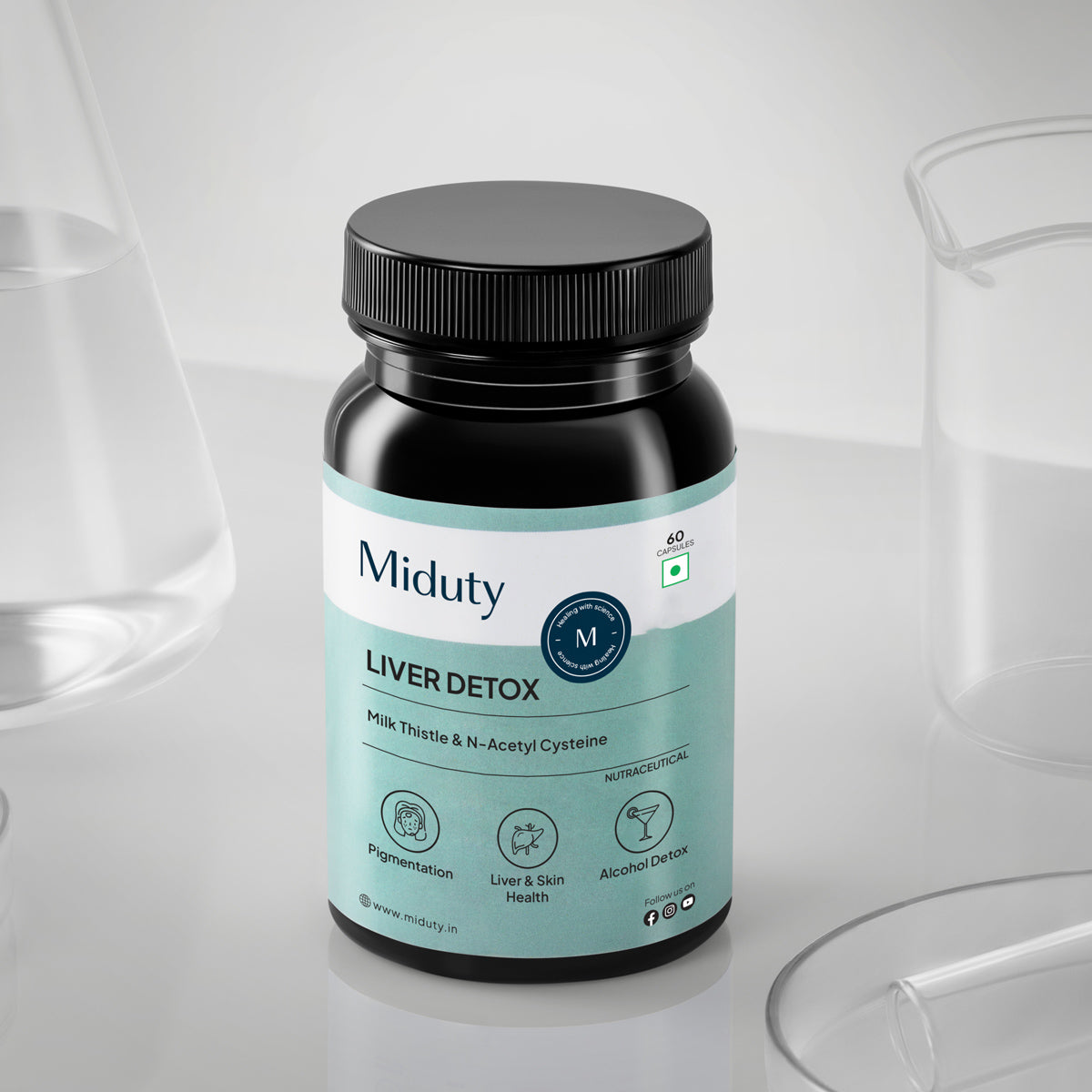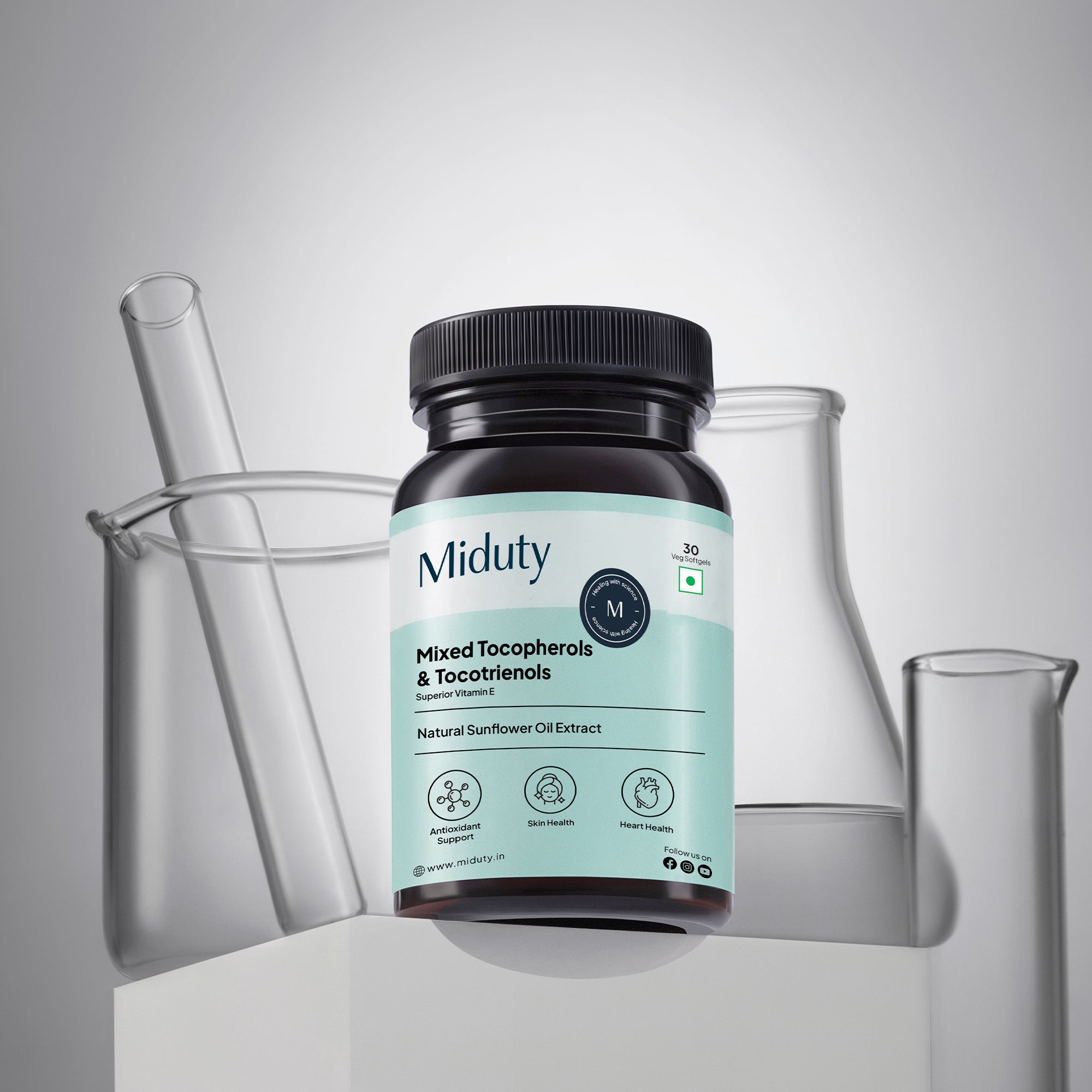
Blue Spirulina vs Green Spirulina: Benefits, Differences & Which Is Better for You?
Spirulina is one of those superfoods that has exploded in popularity over the last decade. You'll see it in smoothie bowls, supplements, lattes, detox drinks, and even skincare products. But once you start searching for spirulina online, something surprising happens: you suddenly discover that there are two kinds: blue spirulina and green spirulina.
And that's when the confusion starts. Which one should you use? Is one healthier than the other? And most importantly, which one is actually better for you?
The truth is, both blue and green spirulina come from the same original algae, but they deliver different nutritional profiles, flavors, and benefits. In this blog, you'll get a detailed comparison of blue spirulina vs. green spirulina, so you can make a confident and informed choice.
Whether you're trying to support your immune system, boost energy, improve skin health or more, this article will help you understand which type suits your goals best.
Key Takeaways
1. Same Algae, Different Benefits: Both blue and green spirulina come from the same original algae but differ in nutrient profiles, flavors, and uses. Green spirulina is a whole-food superfood, while blue spirulina is a concentrated phycocyanin extract.
2. Green Spirulina = Complete Nutrition: Green spirulina is nutrient-dense, packed with 55-70% protein, all essential amino acids, chlorophyll, B-vitamins, minerals, and antioxidants, making it ideal for daily nutrition, detox, and energy support.
3. Blue Spirulina = Antioxidant Power: Blue spirulina is rich in phycocyanin, a potent antioxidant and anti-inflammatory compound. It's perfect for skin health, anti-aging, reducing inflammation, and boosting immunity.
4. Immune & Energy Benefits: Both types support immunity and energy, but green spirulina provides broader nutritional support, while blue spirulina focuses on cellular protection, oxidative stress reduction, and mitochondrial function.
5. Beauty & Skin Focus: Blue spirulina enhances skin glow, supports collagen, and protects against free radical damage, whereas green spirulina supports hair, skin, and nails through essential nutrients, amino acids, and antioxidants.
What Is Spirulina?
Spirulina refers to Arthrospira platensis or A. maxima, one of the oldest superfoods on Earth. What makes spirulina so important is that, unlike most plant-based foods, spirulina contains a high concentration of complete proteins, meaning it includes all nine essential amino acids your body can't produce on its own. It's also loaded with vitamins like B1, B2, and B3, plus vital minerals such as iron, magnesium, and potassium. On top of that, spirulina is rich in antioxidants and anti-inflammatory compounds that help protect your body from oxidative stress and support long-term wellness. [1]
There are two popular varieties:
- Green Spirulina (whole spirulina)
- Blue Spirulina (extracted pigment, also known as phycocyanin)
Both come from the same original algae species but are processed differently, resulting in very different colors, flavors, nutrients, and uses. Understanding this difference is key to deciding which one is best for your health goals and lifestyle.
What is Green Spirulina?
Green spirulina is the traditional form of spirulina, derived from the blue-green algae species Arthrospira platensis or Arthrospira maxima. It is harvested from freshwater sources, then washed, dried at low temperatures, and ground into a fine green powder, retaining its full nutritional profile. Its deep green color comes from chlorophyll, which supports detoxification, liver cleansing, and oxygen transport.
What Green Spirulina Contains?
Green spirulina is a nutrient-dense superfood known for its impressive health benefits. It contains 55-70% complete protein, including all essential amino acids, making it an excellent plant-based protein source. [2] Rich in chlorophyll, green spirulina supports natural detoxification and boosts overall vitality. It also contains phycocyanin (in smaller amounts than blue spirulina), a powerful antioxidant with anti-inflammatory properties. Along with iron, magnesium, potassium, and B vitamins, it provides nutrients essential for energy, metabolism, and immune support. Green spirulina also offers essential fatty acids like GLA and a variety of antioxidants, making it a top choice for anyone looking to improve wellness, energy, and cellular health through natural nutrition.
Benefits of Green Spirulina
1. Immune System Support
Green spirulina is rich in phycocyanin, polysaccharides, and essential micronutrients, which collectively enhance immune function. Clinical studies show that it can boost natural killer (NK) cell activity and improve lymphocyte function, helping the body respond more effectively to infections. A 16-week study found Spirulina can help improve immunity and lower inflammation in older adults.
Its effects may be different for each person depending on their genes. Regular supplementation has also been linked to reduced symptoms of allergies like allergic rhinitis, supporting a stronger, balanced immune system. [3]
2. Detox & Liver Support
The high chlorophyll content in green spirulina binds to toxins and heavy metals in the body, while phycocyanin supports antioxidant defenses in the liver. Together, they help reduce liver inflammation, promote detoxification, and enhance the liver's natural ability to process and eliminate harmful substances. Animal and small human studies have shown that green spirulina can reduce arsenic and heavy metal toxicity and improve liver enzyme markers. In one study, spirulina supplementation decreased cadmium concentration in liver and kidney by over 40%. [4]
3. Improved Energy & Stamina
Green spirulina is loaded with iron, B vitamins, and high-quality plant protein, all essential for energy production. Iron supports healthy hemoglobin levels, B vitamins aid metabolism, and protein sustains muscle function. As a result, supplementation can combat fatigue, improve stamina, and reduce symptoms of mild anemia, making it a natural energy booster.
4. Cardiometabolic Benefits
Regular green spirulina intake has been associated with reduced LDL cholesterol and triglyceride levels. Its antioxidant and anti-inflammatory compounds help protect the heart and support healthy blood pressure. These effects collectively contribute to better cardiovascular health and improved metabolic markers. Taking 2-4 grams of spirulina daily for 3 months can help lower "bad" LDL cholesterol by 31-45%, reduce total cholesterol by 22-33%, and slightly raise "good" HDL cholesterol. [5]
5. Hair, Skin & Nails
Green spirulina provides amino acids, iron, vitamins, and antioxidants necessary for the growth and repair of hair, skin, and nails. It promotes collagen formation, reduces oxidative stress that accelerates skin aging, strengthens hair strands, and supports overall nail health, making it a holistic beauty-supporting superfood.
What is Blue Spirulina?
Blue spirulina usually refers not to the whole algae but to a concentrated extract of phycocyanin, the blue pigment-protein found in spirulina. Manufacturers extract phycocyanin from dried spirulina biomass using water-based, cold extraction and filtration; the result is a bright blue powder or liquid that's mostly phycocyanin with only small amounts of the rest of the algae. Because the pigment is isolated, blue spirulina lacks much of the whole-algae nutrient matrix (chlorophyll, the full complement of minerals, and the same protein content per gram). [6]
Blue spirulina is produced through a precise and natural process. First, the spirulina biomass is carefully harvested and dried. From this dried biomass, phycocyanin, the pigment responsible for its vibrant blue color, is extracted using a cold water method to preserve its potency and nutrients. The final product is a bright blue powder with a neutral taste, making it easy to incorporate into foods, beverages, and supplements.
Phycocyanin is a pigment-protein with strong antioxidant and anti-inflammatory activity. Preclinical and clinical research show it can scavenge free radicals and modulate inflammatory signaling (reducing markers such as TNF-α, IL-6 in models). [7]
What Blue Spirulina Contains?
Blue spirulina is a highly concentrated antioxidant superfood derived from green spirulina, with its vibrant color coming from phycocyanin, a powerful compound known for its anti-inflammatory and immune-boosting properties. Blue spirulina contains up to 18% phycocyanin by weight, which is 4-5 times more than what's found in regular green spirulina. [8]
Unlike green spirulina, blue spirulina is free from chlorophyll and has a milder taste and smoother texture, making it ideal for smoothies and wellness drinks. It's rich in complete protein and provides all essential amino acids, along with vital nutrients like B-vitamins, iron, and trace minerals. Blue spirulina is especially popular for its skin-enhancing benefits, as its antioxidant content helps fight oxidative stress, supports collagen production, and promotes a natural glow. Perfect for detox, energy, and skin health, blue spirulina is a clean, plant-based supplement that fits seamlessly into any wellness routine.
Benefits of Blue Spirulina
1. Energy & Immune Support
Blue spirulina enhances mitochondrial function, helping the body produce cleaner, more efficient energy. It also strengthens immune protection by supporting immune cell activity and detox enzyme systems. This means better resilience, quicker recovery, and more sustained energy throughout the day. It's especially helpful for individuals experiencing fatigue, stress, or low immunity.
2. Potent Antioxidant Activity
Blue spirulina is rich in phycocyanin, one of the most powerful natural antioxidants studied today. Blue spirulina contains antioxidant activity comparable to matcha, blueberries, and acai, but in a more concentrated form. Research shows phycocyanin helps neutralize free radicals, lower oxidative stress, and protect cells from inflammation-induced damage. A 2022 scientific review highlighted its ability to downregulate inflammatory pathways like TNF-α and IL-6, which play major roles in chronic diseases. This makes blue spirulina a top choice for anti-aging, cellular protection, and overall wellness. [9]
3. Anti-Inflammatory Power
Chronic inflammation is linked to arthritis, heart disease, digestive problems, and faster aging. Phycocyanin works as a natural COX-2 inhibitor that helps inhibit inflammation at the cellular level by downregulating inflammatory molecules. This makes blue spirulina effective for calming symptoms related to joint pain, allergies, skin inflammation, and other inflammatory concerns. Its inflammation-calming properties also help repair muscles after exercise and soothe skin irritation. Over time, this leads to improved mobility, comfort, and overall recovery. [10]
4. Skin Health & Anti-Aging
Because free radical damage accelerates wrinkles, pigmentation, and dullness, blue spirulina's antioxidants help the skin look younger and healthier. Phycocyanin supports collagen structure, improves skin glow, and reduces oxidative stress caused by pollution and UV exposure. This helps prevent premature aging, reduces uneven tone, and promotes a smoother complexion, making it a popular choice in beauty elixirs and skincare-focused routines.
Blue Spirulina vs Green Spirulina: Key Differences
While both blue and green spirulina come from the same algae source, they differ in color, nutrient composition, and benefits. Here's a quick comparison to help you choose the right one for your health goals:
|
Feature |
Blue Spirulina |
Green Spirulina |
|
Also known as |
Phycocyanin extract |
Whole spirulina powder |
|
Color |
Bright blue |
Deep green |
|
Taste |
Neutral |
Algae-like |
|
Nutrient density |
Low |
Very high |
|
Phycocyanin |
Extremely high |
Moderate |
|
Chlorophyll |
None |
Very high |
|
Protein |
Low |
High (up to 70%) |
|
Vitamins / Minerals |
Low |
High |
|
Antioxidant strength |
Very high per gram |
High overall |
|
Detoxification |
Moderate |
Excellent |
|
Best for |
Beauty, skin, anti-inflammation |
Daily nutrition, detox, immunity, vegans |
Which One Should You Choose?
Both blue and green spirulina offer unique health benefits, but the right choice depends on your specific wellness goals. Here's how to decide which one fits your needs best:
Choose Blue Spirulina If You Want:
Blue spirulina is ideal for those who want a clean, tasteless superfood packed with antioxidants. It's perfect for beauty-focused routines and quick, convenient use in smoothies or wellness drinks.
- A flavorless antioxidant boost for easier mixing in recipes
- Improved skin glow and radiance through cellular protection
- Anti-aging benefits thanks to high phycocyanin content
- Targeted inflammation relief and immune system support
Choose Green Spirulina If You Want:
Green spirulina is a nutrient-dense, whole-food supplement that delivers complete protein, chlorophyll, and a broad range of vitamins and minerals ideal for full-body wellness.
- A powerful plant-based protein source for muscle and recovery
- Daily vitamins and minerals to support energy and metabolism
- Natural detox and liver support from chlorophyll content
- Increased stamina and vitality for active lifestyles
Final Verdict: Which is Better For You?
When it comes to blue spirulina vs green spirulina, there's no one-size-fits-all answer both offer powerful benefits, but serve different purposes. Choose blue spirulina if your focus is on antioxidant protection, skin health, and anti-aging, especially if you prefer a tasteless, easy-to-mix supplement. On the other hand, green spirulina is your go-to for complete nutrition, detox support, and muscle recovery, making it ideal for those seeking a daily whole-food superfood. Ultimately, the best spirulina for you depends on your personal health goals and nutritional needs and some may even benefit from using both as part of a well-rounded wellness routine.
FAQ's on Blue vs Green Spirulina
Q1. What is the best type of spirulina to take?
The best type of spirulina depends on your goals: choose green spirulina for daily nutrition, protein, detox, and overall wellness, or blue spirulina for a concentrated antioxidant boost, skin health, and anti-inflammatory support. For maximum benefits, some people combine both to get nutrients plus potent phycocyanin.
Q2. Which is healthier, blue or green spirulina?
Green spirulina is generally healthier as a whole-food supplement because it provides protein, vitamins, minerals, and broad nutrient support. Blue spirulina is highly concentrated in antioxidants but lacks most nutrients, so it's better used for targeted benefits like skin, anti-aging, or inflammation support.
Q3. Can you take blue and green spirulina together?
Yes, you can take blue and green spirulina together. Combining them provides the full spectrum of nutrients from green spirulina along with the high antioxidant and anti-inflammatory benefits of blue spirulina, making it a powerful daily supplement for overall health and wellness.
Q4. Is Blue Spirulina and Green Spirulina the same?
No, blue and green spirulina are not the same. Green spirulina is the whole algae, rich in protein, vitamins, minerals, and chlorophyll, while blue spirulina is a phycocyanin-rich extract of the pigment only, primarily offering antioxidant and anti-inflammatory benefits.
Q5. Why do people take blue spirulina?
People take blue spirulina mainly for its powerful antioxidant and anti-inflammatory properties, which support skin health, reduce oxidative stress, and promote overall wellness. Its neutral taste and vibrant blue color also make it popular for smoothies, lattes, and beauty-focused routines.
Q6. Why do people take green spirulina?
People take green spirulina for its complete nutritional support, including high-quality protein, vitamins, minerals, and antioxidants. It helps boost immunity, support detox, improve energy, and promote overall health, making it a popular daily superfood supplement.
References













